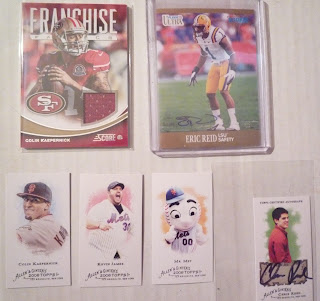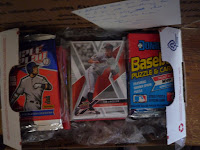The Autumn Wind is a pirate
Blustering in from sea,
With a rollicking song, he sweeps along,
Swaggering boisterously.
His face is weather beaten.
He wears a hooded sash,
With a silver hat about his head,
And a bristling black mustache.
Blustering in from sea,
With a rollicking song, he sweeps along,
Swaggering boisterously.
His face is weather beaten.
He wears a hooded sash,
With a silver hat about his head,
And a bristling black mustache.
He growls as he storms the country,
A villain big and bold.
And the trees all shake and quiver and quake,
As he robs them of their gold.
A villain big and bold.
And the trees all shake and quiver and quake,
As he robs them of their gold.
The Autumn Wind is a raider,
Pillaging just for fun.
He'll knock you 'round and upside down,
And laugh when he's conquered and won.
Pillaging just for fun.
He'll knock you 'round and upside down,
And laugh when he's conquered and won.
~~~~~~~~~~~~~~~~~~~~~~~~~~~~~~~~~~~~~~~~~~~~~~~~~~~~~~~~~~~~~~~~~~~~~~~
I was going to again lead off this post with a disclaimer/apology regarding the fact that there was yet again a sizable gap of time between posts, but I think that the crux of the narrative itself will be more than sufficient. As noted the first time in which the rhythm of these postings was disrupted, concentration levels and energy are key for me when it comes to being able to be locked into writing, particularly since my writing style is rather averse to doing things piecemeal. When it comes specifically to this blog, it certainly has not been for lack of interest or oversight, as I have often thought about the planned construct of future topics and have consistently read others' works. It is also not due to a deficit of topics, as I have a lengthy list from which to draw and received two really amazing trade packages from other bloggers that I am eager to display - both as a thank you to those who took the time to find/send me cool stuff as well as the likelihood that many who read this site will also enjoy seeing the contents of these packages.
Over the last few weeks, however, it has been a major struggle to find the groove necessary in order to sit down and pen anything that I would consider to be worthwhile in terms of depth and/or length. This is due to a multitude of dynamics, none of which can necessarily be pinned down as being *the* cause for any issues that I have experienced. The outset of a new school year has certain brought with it more commitments and obligations than did the summer - this despite the fact that I have not even done any subbing at the schools thus far. I help run the local rec basketball leagues for high schoolers, which is a very fun affair on the whole, yet also includes a lot of small responsibilities and events that can add up as minor stressors often do. Similarly, this has been a year in which small injuries, illnesses, and irritations have almost comically popped up one after another. In addition to a nagging nasal issue that I have had since January (first diagnosed as sinusitis, then allergies, now currently ¯\_(ツ)_/¯), I have experienced a ton of short-term muscle pulls, allergic reactions, anxiety spikes, and other concerns that would go away just in time for the next one to arrive. Again, I feel as though I cannot really complain given that most of these ailments did not have much staying power, thereby paling in comparison to the issues experienced by those who live with chronic pain. It has merely been consistently obnoxious to see the cliché of "it is always something" play out with such regularity.
 |
| 1991 Pro Set Premium Howie Long |
More than anything, though, the issue that causes hiatuses such as these or delays in completing certain open-ended tasks is tied to sleep. To the best of my recollection, I slept pretty well prior to the advent of my concussions, but that dynamic has gradually worsened as time has progressed. I have been prescribed a myriad of sleep aids and tried various dosage amounts of melatonin, most of which initially worked at helping me fall asleep, failed to permit me to consistently sleep through the night, and swiftly lost their level of efficacy very quickly. I have played around with so many other variables in an effort to find that ideal zone that will facilitate quality sleep, yet it often remains elusive. There are times in which it is easier for me to sleep when the temperature is cool and I bundle up in blankets, other times it is preferable for the temperature to be warm and cooling down eases me into sleep. The very same day, neither thing could be true and I lie awake for hours despite feeling exhausted. It is perplexing.
The two variables that do consistently help facilitate sleep, though, are finding a way to block out as much light as possible and having some manner of ambient noise. The latter is easy in the spring and summer months, as I can simply turn on a fan to both cool off the room and serve as a blocker of the many individual noises that can serve as distractions as I try to put my mind to rest. In the northeast, however, this week brought with it the reality that autumn is indeed here, as temperatures dropped nearly 30 degrees from Wednesday to Thursday and, save for a minor push back into the 70s tomorrow, it looks as though cooler weather will be here to stay. As such, keeping a fan on as temperatures dip into the low 50s/high 40s at night becomes both impractical and unwise. Finding an alternative, however, has been surprisingly difficult. After my grandfather's passing, I inherited his white noise machine, only to discover that all of the supposedly distinct sounds that it made hit my ears like a jackhammer blasting into concrete - even when played at the lowest setting and muffled under a pile of clothes. Other efforts at playing artificial background noise have proven similarly fruitless, which tends to lead to many long, restless nights in the winter.
This week did, however, remind me of just how restful my sleep can be when the natural ambient noise is conducive to creating a positive sleep rhythm. The aforementioned temperature drop mid-week was due to what felt like the first lengthy rain storm that we have had here in quite a while, one that was accompanied by a whistling wind that, at least to me, is distinctly found in the fall. While I also love to sleep during summer's thunderstorms, they are characterized more by power and force than anything else, with this past summer's storms often being fairly short-lived. In contrast, while the autumn wind can certainly create a feeling of rawness for those who meet it head-on, I love the manner in which its interplay with the rain creates a strangely restful milieu. I slept pretty well for parts of Thursday and again as it rained today, finally providing enough focus to get back to some of the things that have fallen through the cracks. The autumn wind may well be a raider, but it was also my friend this week.
~~~~~~~~~~~~~~~~~~~~~~~~~~~~~~~~~~~~~~~~~~~~~~~~~~~~~~~~~~~~~~~~~~~~~~~
Although I no longer watch or support the NFL given the many, many reasons that it has provided as evidence that it values money and power over humanity (I also fully acknowledge that the other professional sports leagues, including the NCAA, are guilty of many similar issues), it would be wrong to pretend as though it did not also bring some positive things into my life. Fairly close to the top of the list would have to be the early works of NFL Films, whose on-field camera work, pointed narrative voice-overs by John Facenda, and inclusion of orchestral music composed by Sam Spence were truly remarkable to experience even several decades after their initial airings. While most TV broadcasts of sports contests in the 1960s and 1970s were shot from oft-grainy fixed camera angles well above the fields of play, with perhaps a quick and jarring cut to an on-field/on-court angle, NFL Films showcased game action in ways that had never before been available to viewers. Between zoomed shots of the actions courtesy of a litany of field level cameramen and clips of coaches/players reacting on the sidelines, the Sabol family was able to collect copious amounts of footage that was then painstakingly edited into the sports equivalent of works of art.
While I would love to take credit for the poem at the outset of this post, the Wiki link notes that it was inspired by a poem by Mary Jane Carr, with Steve Sabol's adapted version then read by the aforementioned Facenda. I listened the the NFL Films soundtrack on loop many times over the years, with there being too many tracks to list as recommendations. However, "The Autumn Wind" was always my favorite for the manner in which it interwove clever writing with Facenda's powerful reading style prior to segueing into a track that builds momentum at almost the perfect pace. The finished product laid over video is what I would consider to be art in the manner that its were painstakingly pieced together so as to form a cohesive and heavily layered whole. It seems fitting to make note of this level of effort this week in particular, as it has been one in which another iconic sports entity from years past, Sports Illustrated, was purchased and subsequently gutted by one of the far too many soulless corporate raider types that overpopulate our society.
Similarly, the NFL now fully owns NFL Films, with the output definitely paling in comparison to what was produced during the company's time in the Sabols' care. This was not necessarily as malevolent as case as SI's demise given that the NFL did not wantonly lay off copious amounts of staff and lie about wanting to increase quality of writing via turning a respectable publication into a content mill staffed by underpaid freelancers in the fashion that the ghouls who purchased SI have done. However, it does feel fair to lament in some fashion an era that does not care terribly much about quality as long as short-term quantity yields enough profit to enrich those in charge while cutting the jobs of those whose hard work produced results far more substantive and memorable than a Top Ten list. Unfortunately, you can find plenty of those in NFL Films' current output and will surely be able to view similar content at SI if its new owners consider that result to be preferable to providing its employees health care. As Ray Ratto ably notes in one of the links above, the type of brilliance and artistry once found in outlets like SI and NFL Films still exists; it will just take time and effort to locate these efforts so that they can be properly appreciated. Nonetheless, it would also be nice if those who took over venerated institutions actually appreciated these qualities, too, rather than behaving more like a swarm of locusts that strip resources to the ground before moving on without a second thought to the destruction left in their wake.













